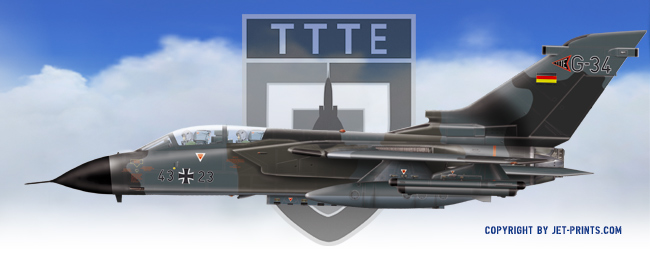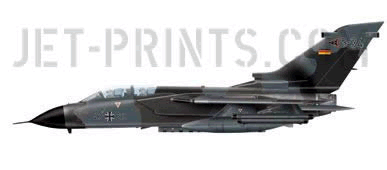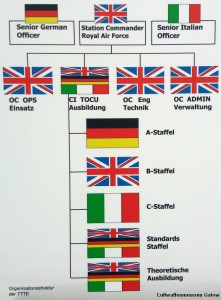|
FBW = Fighter Bomber Wing
TTTE = Trinational Tornado Training Establishment
a.o.s. = out of service
|
| Sorry - parts of the texts are still german language! |
 |
ttte jets
The TTTE performed training on the Panavia PA-200 Tornado for the Royal Air Force, the German Luftwaffe and the Italian Air Force. All three nations provided a specific number of aircraft, which kept their national markings, schemes and colors but were marked with a special TTTE Marking on top of the tail. Allocation of aircraft was:
- Germany: 23,
- UK: 19, and
- Italy: 6.
Later a distinction was made between A, B, C and S squadron. The S (Standards) squadron was the unit responsible for training instructor pilots and WSO/Navigators, as well as further going courses and conducting check flights for both, students and instructors. All these squadrons applied their markings to the aircraft. |
 |
|
IDS Norm 76 |
|
|
 |
TTTE - The Unit and its task
The Tri-National Tornado Training Establishment (TTTE) performed training on the Panavia Tornado for the Royal Air Force, German Luftwaffe and Italian Air Force.
The TTTE was responsible for the initial training of all Tornado aircrew as well as providing additional courses for experienced aircrew. Funding was allocated according to workshare in the project, accordingly Germany 42.5%, Great Britain 40% and Italy 17.5%. Cottesmore was chosen as the base for TTTE operations, having previously been placed on Care & Maintenance. The post of Officer Commanding TTTE rotated through the nationalities, having the title of Chief Instructor.
Split into different flying units, the flying element of the TTTE was the Tornado Operational Conversion Unit (TOCU) which comprised 'A', 'B' and 'C' Squadrons, commanded by a German, Brit and Italian respectively, and the Standards Squadron, responsible for advanced training, instrument rating checks and special tasks (for example training the instructors and refresher training). Also assigned to the TTTE was the Chief Ground Instructor, again the post rotated through the nations, who controlled four principal types of training aid; the Basic Flight Simulator, the Full Mission Simulator, the Nav-Attack Systems Trainer and the Basic Avionics Procedures Trainer.
All instruction was in English, not such a problem as one might think as it is the international language of air to air communications. This enabled mixed nationality sorties to be done, further fostering relations between the three nations.
No weapons training has been done at Cottesmore, this was and is a function of the Operational Conversion Units in each air force.
|
 |
TTTE Patches |
|
|
|
|
|
TTTE Patch |
A-Sqdn Patch |
B-Sqdn Patch |
C-Sqdn Patch |
Groundschool Patch |
|
 |
Base Position
The Tri-National Tornado Training Establishment (TTTE) was based at RAF Cottesmore in Rutland County, England. The name of the airfield is derived from the little village Cottesmore next to it. The next big Town is Peterborough, approx. 30 Km southeast of the station.
|
 |
History
 A memorandum of understanding establishing the unit was signed in 1979 by the United Kingdom, Germany and Italy and the unit came into existence on 29 January 1981. The first RAF Tornados arrived at the base on 1 July 1980; Luftwaffe Tornados arrived on 2 September 1980; and Italian Tornados arrived much later on 5 April 1982. Flying training began on 5 January 1981. The unit was manned by personnel of all three participating nations, trained 300 crews a year when at its height and consisted of three, later four squadrons of Tornados. All servicing was done by RAF groundcrew. A memorandum of understanding establishing the unit was signed in 1979 by the United Kingdom, Germany and Italy and the unit came into existence on 29 January 1981. The first RAF Tornados arrived at the base on 1 July 1980; Luftwaffe Tornados arrived on 2 September 1980; and Italian Tornados arrived much later on 5 April 1982. Flying training began on 5 January 1981. The unit was manned by personnel of all three participating nations, trained 300 crews a year when at its height and consisted of three, later four squadrons of Tornados. All servicing was done by RAF groundcrew.
In the post-Cold War era, the three nations decided that they would be better served performing their own type training. There was also a need to find space for British aircraft returning to the UK from bases in Germany, such as RAF Bruggen, that were closing. Consequently the unit disbanded on 24 February 1999, with Tornado flying ending on 31 March 1999.
While the Eurofighter project has followed the example of the Tornado programme in many ways, the TTTE model was not adopted. Rather the Eurofighter partners (Germany, Italy, Spain and United Kingdom) have chosen to run national training schemes. Germany outsourced the basic training to Holloman AFB in New Mexico, USA. After this detachment was also closed the training was transferred to Tactical Luftwaffe Wing 51 "Immelmann" in Jagel/Schleswig which opened a 4th squadron for this task. |
 |
|

